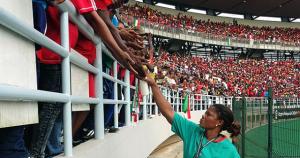Protecting fans from Ebola at the Africa Cup of Nations in Equatorial Guinea
Thanks to preparedness activities by Equatorial Guinea’s Ministry of Health, FIFA and WHO, the one million people gathered in Equatorial Guinea for the 2015 Africa Cup of Nations are able to focus more on footie than on fears of Ebola.
So what does it take to ensure that capacities are in place to prevent, identify and respond to potential Ebola virus transmission at such a large mass gathering?
Mass gatherings: A growing science
"Large mass gatherings like the FIFA World Cup, the Olympic Games or the Africa Cup of Nations are highly visible events and offer the occasion to promote long lasting health legacies," says Dr Maurizio Barbeschi, WHO scientist and team leader for the WHO preparedness and mass gatherings team. Dr Barbeschi and colleagues have published numerous articles on mass gatherings and disease surveillance and control, including a recent series in The Lancet.
"Mass gatherings require extensive preparation," adds Nicolas Isla, WHO technical officer within the same team, now deployed in Equatorial Guinea for AFCON. "Coordinated surveillance and alert systems have to be installed in each point of entry, stadium and hospital. Rapid response teams, dedicated health-care facilities and labs must be developed and ready to handle any potential cases. Health authorities must ensure that local and visitor populations are educated about early symptoms of Ebola and how to protect themselves. Hand washing areas, mobile toilets, isolation areas and personal protective equipment must be placed in strategic areas. This is no small feat."
These activities are in addition to regular large mass gathering preparedness activities that also must be in place, such as plans for controlling crowds and dealing with traumatic injuries, food and water borne illnesses, weather and physical structure disasters, and terrorism concerns.



